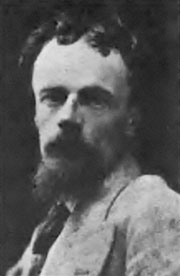John Atkinson Grimshaw

John Atkinson Grimshaw (6 September 1836 – 13 October 1893) was a Victorian-era artist, a "remarkable and imaginative painter"[1] known for his city scenes and landscapes.[2][3]
His early paintings were signed "JAG," "J. A. Grimshaw," or "John Atkinson Grimshaw," though he finally settled on "Atkinson Grimshaw."
Life
He was born 6 September 1836 in Leeds. In 1856 he married his cousin Frances Hubbard (1835-1917). In 1861, at the age of 24, to the dismay of his parents, he departed from his first job as a clerk for the Great Northern Railway to pursue a career in art. He began exhibiting in 1862, under the patronage of the Leeds Philosophical and Literary Society, with paintings mainly of birds, fruit, and blossoms.[4] He became particularly successful in the 1870s and was able to afford to rent a second home in Scarborough, which also became a favourite subject.
Work

Grimshaw's primary influence was the Pre-Raphaelites. True to the Pre-Raphaelite style, he put forth landscapes of accurate color and lighting, and vivid detail. He often painted landscapes that typified seasons or a type of weather; city and suburban street scenes and moonlit views of the docks in London, Leeds, Liverpool, and Glasgow also figured largely in his art. By applying his skill in lighting effects, and unusually careful attention to detail, he was often capable of intricately describing a scene, while strongly conveying its mood. His "paintings of dampened gas-lit streets and misty waterfronts conveyed an eerie warmth as well as alienation in the urban scene."[5]
Dulce Domum (1855), on whose reverse Grimshaw wrote, "mostly painted under great difficulties," captures the music portrayed in the piano player, entices the eye to meander through the richly decorated room, and to consider the still and silent young lady who is meanwhile listening. Grimshaw painted more interior scenes, especially in the 1870s, when he worked until the influence of James Tissot and the Aesthetic Movement.[6]
On Hampstead Hill is considered one of Grimshaw's finest, exemplifying his skill with a variety of light sources, in capturing the mood of the passing of twilight into the onset of night. In his later career this use of twilight, and urban scenes under yellow light were highly popular, especially with his middle-class patrons.[7]
His later work included imagined scenes from the Greek and Roman empires, and he also painted literary subjects from Longfellow and Tennyson — pictures including Elaine and The Lady of Shalott. (Grimshaw named all of his children after characters in Tennyson's poems.)[8]
In the 1880s, Grimshaw maintained a London studio in Chelsea, not far from the comparable facility of James Abbott McNeill Whistler. After visiting Grimshaw, Whistler remarked that "I considered myself the inventor of Nocturnes until I saw Grimmy's moonlit pictures."[9] Unlike Whistler's Impressionistic night scenes, however, Grimshaw worked in a realistic vein: "sharply focused, almost photographic," his pictures innovated in applying the tradition of rural moonlight images to the Victorian city, recording "the rain and mist, the puddles and smoky fog of late Victorian industrial England with great poetry."[10]

Grimshaw's paintings depicted the modern world but managed to escape the depressing, dirty reality of industrial towns. Shipping on the Clyde for instance, a depiction of Glasgow's Victorian docks, is a lyrically beautiful evocation of the industrial era. Grimshaw transcribed the fog and mist so accurately as to capture the chill in the damp air, and the moisture penetrating the heavy clothes of the few figures awake in the misty early morning.
Some artists of Grimshaw's period, both famous and obscure, generated rich documentary records; Vincent Van Gogh and James Smetham are good examples. Others, like Edward Pritchett, left nothing. Grimshaw left behind him no letters, journals, or papers; scholars and critics have little material on which to base their understanding of his life and career.
Grimshaw died 13 October 1893, and is buried in Woodhouse cemetery, Leeds. His reputation rested, and his legacy is probably based on, his townscapes. The second half of the twentieth century saw a major revival of interest in Grimshaw's work, with several important exhibits of his canon.
References
- ^ Christopher Wood, Victorian Painting, Boston, Little, Brown & Co., 1999; p. 173.
- ^ Alexander Robertson, Atkinson Grimshaw, London, Phaidon Press, 1996.
- ^ H. J. Dyos and Michael Wolff, eds., The Victorian City: Images and Realities, 2 Volumes, London, Routledge, 1973.
- ^ Isabella Steer, The History of British Art, Bath: Parragon, 2002; p. 154. ISBN 0-75257-602-X
- ^ Philip J. Waller, Town, City, and Nation, Oxford, Oxford University Press, 1983; p. 99.
- ^ Wood, pp. 264-5.
- ^ Steer, p. 154.
- ^ Wood, p. 172.
- ^ Lionel Lambourne, Victorian Painting, London, Phaidon Press, 1999; p. 112.
- ^ Lambourne, pp. 112-13.
External links
- Atkinson Grimshaw
- A collection of Grimshaw paintings
- Royal Academy biography
- Johnatkinsongrimshaw.org 85 works by John Atkinson Grimshaw
- Shipping on the Clyde in Glasgow from Grimshaw, a Thyssen Museum's project on Flickr
- Artcyclopedia.com
- Phryne's list of paintings by Grimshaw in accessible collections in the UK
- Paintings Leeds Collection
